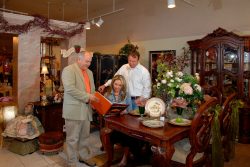History of the Jacobs-Hutchinson Block
October 19, 2020
Jacobs-Hutchinson Block, also known as Peoples’ National Bank and Friendly Furniture Store, is a historic commercial building located in downtown Fairmont.
Construction
Measuring 92 feet by 80 feet deep and 84 feet high, the five stories tall Jacobs-Hutchinson Block was designed by Andrew C. Lyons, and constructed by Holbert & Spedden, and was built in 1901-1902. The building owners were George M Jacobs, J.M. Jacobs, M.L. Hutchinson, and Clyde E. Hutchinson. (Learn more about Andrew Lyons works in “Art and Architecture of Fairmont by M. Raymond Alvarez).
Built as the largest commercial building in Fairmont, it appears to be one unified block. However, the building is four separate businesses portioned vertically. When it opened in November 1902, J.M. Hartley & Son occupied the two eastern quarters nearest the Courthouse: W.H. Billingslea, a furniture dealer, occupied the western corner quarter, and Casterline and Hoge, proprietors of the Racket Store occupied the quarter in between the two other stores.
New owner
In July 1903, T.W. Fleming purchased the Jacob-Hutchinson Block for $50,000. The Peoples National Bank had the first floor rebuilt and remodeled in the Colonial Trust Company’s building in Pittsburgh style.
In 1904, Peoples National Bank (later to become Union National Bank) purchased the corner “house” and opened its new banking quarters on March 29 of that year; Mr. Billingslea relocated his business. The Peoples National Bank is located on the first floor only. It rented the upper floors to other offices, including the Consolidated Telephone Company, the offices of H. H. Lanham, Realtor, and Pickering and Earle, Brokers.
The quarter of the Jacob-Hutchinson Block was occupied initially by the Racket Store when the store first opened relocated to the adjacent Jacobs Building (312 Monroe Street); the Jacobs-Hutchinson Hardware Company subsequently occupied the storefront. The company carried one of the most extensive lines of hardware in the state at the time. The enterprise occupied all six floors of their quarter of the block.
Founded in 1902, Jacobs and Hutchinson started as a Coal Company store, owned by the Hutchinson Coal Company. A company store sells a limited range of food, clothing, and daily necessities to employees of a company. It is typical of a company town in a remote area where virtually one company employs everyone, such as a coal mine. However, instead of selling food, the store provided rakes and shovels to the mineworkers.
People’s Bank moved from this location when three local banks merged.
Hartley’s Department Store
J. M. Hartley & Son, “pioneers in the department store business since 1877”, eventually occupied most of the structure. The department store expanded into the adjacent Jacobs Building via a connecting walkway. In 1971, a small one-story addition was placed in Monroe Street’s alley between the two buildings and used as a loading dock.
Hartley’s had moved from its original location on the southeast corner of Adams and Jefferson Street, which had become overcrowded, to the Jacobs-Hutchinson Block in 1902. They proceeded to conduct business “on the lines of big city stores”. The store continually updated and modernized its quarters and expanded as space would allow. Hartley’s had “a safe and speedy elevator and a cash carrier system reaching from basement to the top floor”. Shortly after it opened, Hartley’s leased the space in the middle quarter of the building occupied by “The Racket”.
In 1912, Hartley’s annexed the four floors above the Peoples National Bank. Hartley’s also leased a first-floor room and basement for stock in the adjacent Jacobs Building, accessible to the Jacobs-Hutchinson Block via an archway on the south side of the first-floor store a Monroe Street entrance. In 1918, the first-floor stockroom in the Jacobs Building served as sales space as an enclosed passageway on the second floor was added above the alley called “The Bridge of Size”, and the store added additional space on the second floor of the Jacobs Building to a total of 40,000 square feet of merchandise.
Joseph Milton Hartley died suddenly as he traveled home from Denver, where he attended a Rotary convention on June 25, 1926. His son, Harry J Hartley, and his business partner John H Rownd managed the store.
The store closed in 1985 after 108 years in business.
Through the years
Hartley’s success finally forced it to move to even larger quarters, as it outgrew the Jacobs-Hutchinson Block; in 1927, it moved to the Fleming Building at 109-113 Adams Street. Jones’ Department Store then moved from its location across the street at 208 Adams Street to the Jacobs-Hutchinson Block, where it closed in 1977.
In July of 1978, the Spatafore Family secured the former Jones Department Store building. And Friendly Furniture opened for business in October of that year.
Friendly Furniture closed in 2014, and the Jacobs-Hutchinson Block now houses the Fairmont Mercantile, home to over 30 vendors, including the Arts & Antiques Marketplace, Unique Consignment, and Cool Ridge. In conjunction with the WV Division of Culture & History, the Northern Appalachian Coal Mining Heritage Association (NACMHA) maintains the Black Diamond Display, a traveling interactive exhibit on the third floor.



